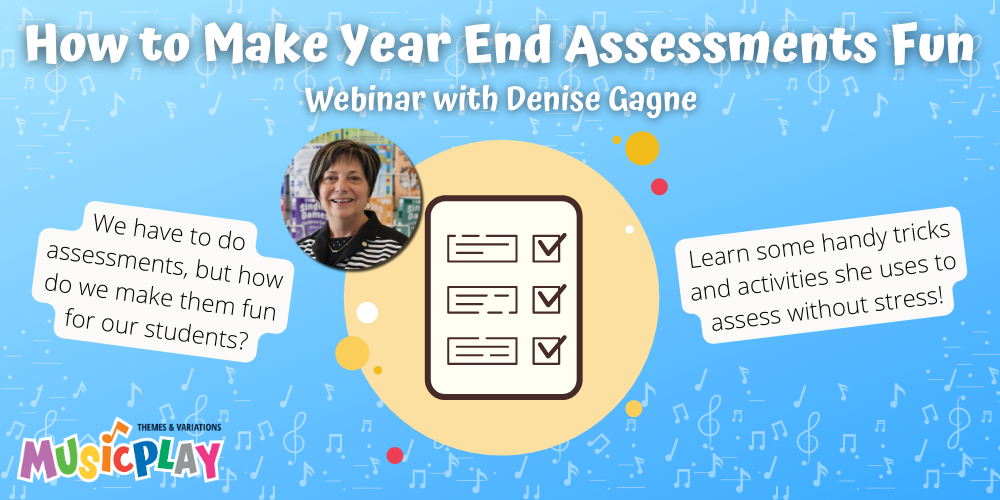Helping Children Develop the Singing Voice
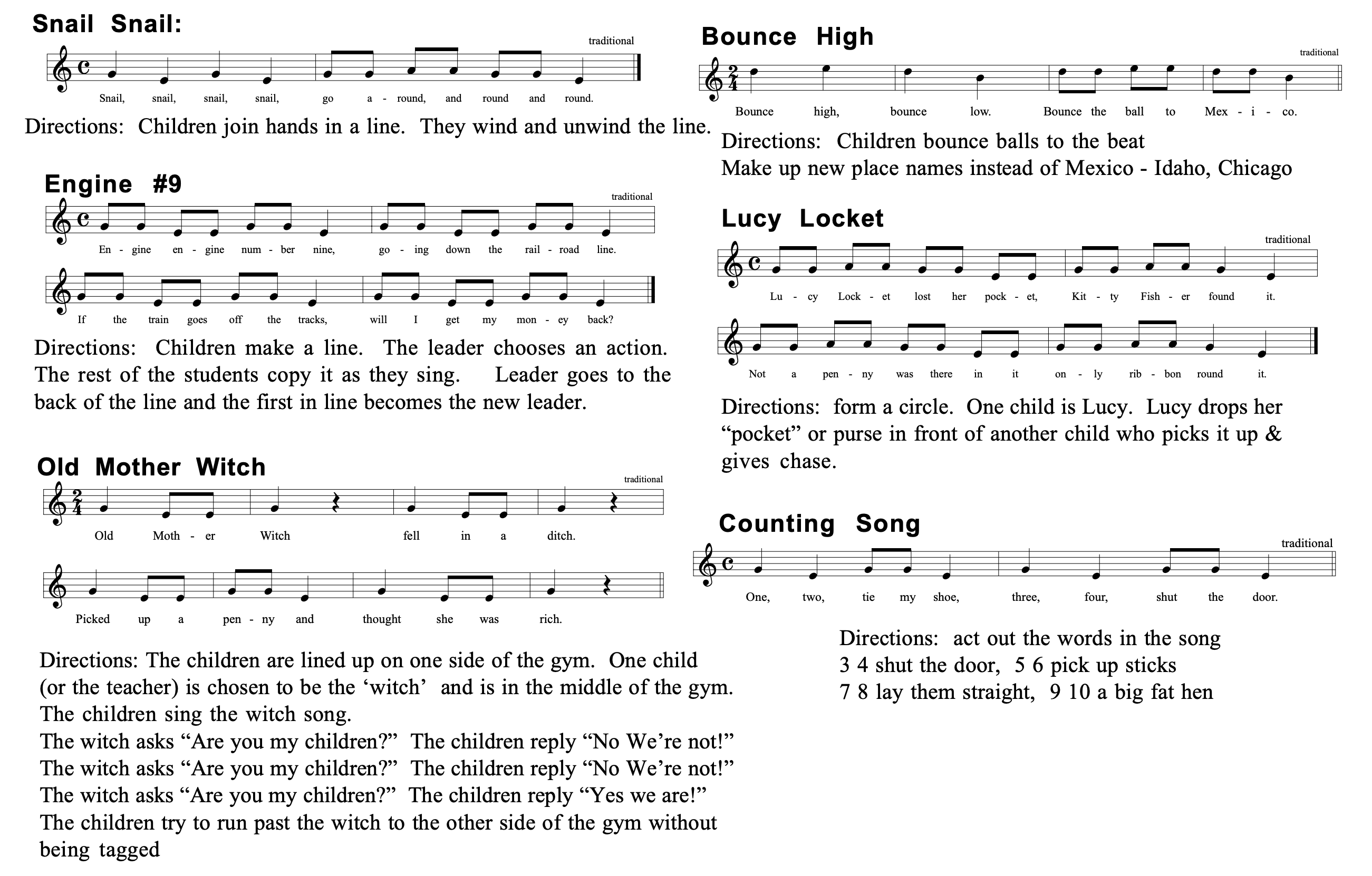
How do we teach children to sing in tune? Children come to elementary school with a variety of pre-school experiences. Some may be singing very well when they come to kindergarten or grade 1. Some may still be using speaking voices or singing only in a very low “chest” voice. A child cannot produce a pitch that they do not perceive. The problem may be that they do not hear the pitch and cannot distinguish pitches. Or, the child may not know what to do to make one pitch sound like another - their vocal mechanism may not be working well.
If the child is not perceiving different pitches, we need to give them many experiences in hearing and singing pitches to help develop their perception. Singing games require the repetition of a song many times during the course of the game. This repetition of a simple game song will help children to improve their perception. Musicplay includes many simple game songs for this purpose: Snail Snail, Cuckoo, Counting Song, Lucy Locket, Bounce High, Old Mother Witch, Doggie Doggie are all songs that will help develop pitch perception.

There are three vocal registers in the child’s voice: chest voice (low), middle (mixed) and head voice (high). The pure upper voice where the inner edges of the folds oscillate generally begins an octave above middle C and extends upward. Pure chest voice should only be used from middle C downwards. Between these two registers is the middle voice which is a combination of both lower and upper registers. Anita Morrison, studio vocal teacher writes “ Children lacking in vocal instruction mostly gravitate to the chest voice which is the speaking voice register and never discover their head voice. This is another cause of 'tone-deaf' singers. Over a sustained period of time this kind of singing can lead to permanent vocal damage as the folds are under a terrific amount of pressure.”
If a child is singing in a low chest voice the teacher needs to work with them to give them the ability to use their head voice. I’ve found the following activities to be very helpful in moving children into head voice.
Speaking/Singing voice:
Some children in K/1 may not be aware of the difference between their singing and their speaking voices. I have an elephant named Melody. When the children tell Melody what to do in a speaking voice, she doesn’t do it. But when they tell her what to do in a singing voice, Melody will do it! If they sing “Melody give me a kiss”, she’ll give them a kiss.
Low/Middle/High Practice:
Speak or chant poems at low, middle and high levels. This helps children to become aware that they can make sound at all levels. In K/1 use “Grandmas’s Glasses”, the story of the “Three Bears” and the story of “Three Billy Goats Gruff” all work well for using 3 different voices. In Musicplay 5 use the chant - “Boom Chicka Boom”
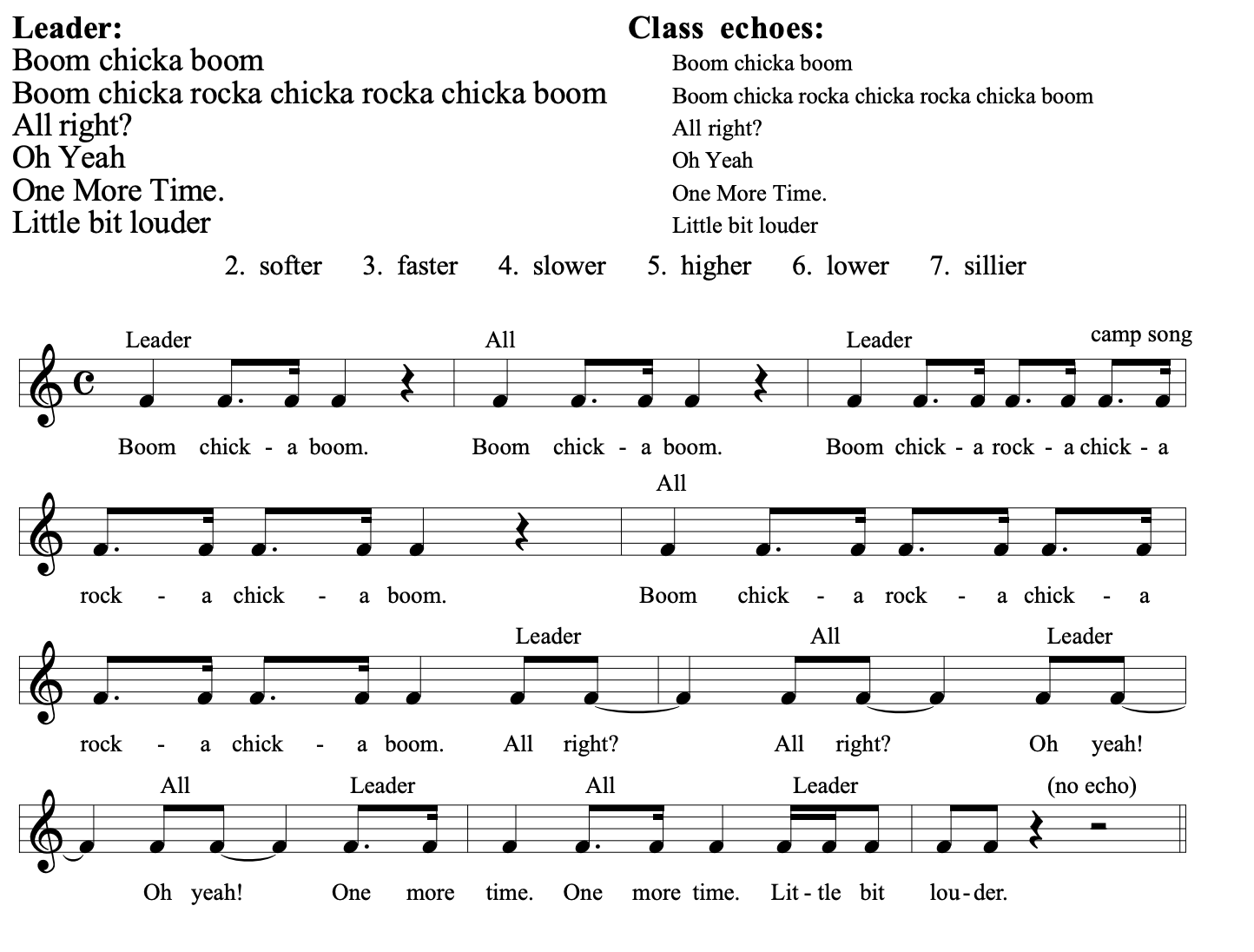
Low/High voice:
Say to your students in a low voice “This is my speaking voice” (use a very low speaking voice and have kids echo) Then in an exagerrated high voice say - “this is my singing voice”. (Kids repeat.)
Vocalise at low, middle and high levels:
- Say oohs and ahs moving the voice up and down to extremes in the range.
- Turn the lights off and show high/low with a flashlight. Follow the flashlight with voices. Have a child use the flashlight.
- Buy a ghost puppet at Halloween and have the puppet say short phrases in a spooky “ghost voice” that the children echo. Be sure to use lots of higher “ghostlike” pitches. For example: Helloooooooo How are youoooooooo? I’m feeling a little eerieeeeeeeee. This kind of vocalising elongating the vowels also helps children to sing on the vowel when they sing in choir.
- Sing songs with big leaps.
- Yodel
- Coyote howls, train whistles
- Toss a bean bag up and follow the bean bag with your voices.
- Hollow telephone or flexible tube: Have the child speak and sing into a hollow telephone so they hear their voice outside themselves.
- Have out of tuners sing easy responses: Old Blue, ooo on the old worman all skin & bones.
- Sing songs with large leaps: Musicplay 3/4/5 “Little Tommy Tinker”. Musicplay 5 “Liza Jane”.
- Sing echo songs - MP1 “The Other Day” , “My Aunt Came Back”, MP4 “Bill Grogan’s Goat”
Sing Alone and in Small Groups:
Children need experience singing alone and in small groups. If they never hear what they sound like alone, they may not realize that they aren’t singing at the correct pitch. I don’t usually have children sing alone for the first month of the school year. By October they know me a little better and we can begin to give them opportunities to sing alone. Sing the attendance. Sing “Hello Allison” and Allison replies “Hello Mrs. Gagne”. I use guessing games to give the children experience singing alone. In the context of a game, children are rarely shy. Guessing games in Musicplay include “Cuckoo”, “Doggie Doggie”, “Little Tommy Tiddlemouse”, “Who’s that” and “”Down Came Johnny”. Guessing games can become tedious. I used to have the child that sang the solo become the next guesser, but the game goes on for so long that children became wiggly. To give more children a “turn” in a 30 minute period, give each child a turn to be the “Guesser” or the “Soloist” but not both in one period. If Johnny is a “guesser” today, I won’t choose him to sing a solo today. I choose a new child to be the “guesser” and a new child to sing the solo. Another way to have children sing alone is to split the class into two groups for echo songs.
When the children have had experience using their voice in low, middle and high registers, they will begin to be able to find the correct pitches to sing. Teach children to sing with an open mouth, take a low, full singers breath, watch, listen, try hard, use energy and be expressive. I teach my students the 7 E’s that lead to excellent singing.
7 E’s of Good Singing: Eyes, Ears, Effort, Energy, Expression, Extra Big Breath, Exceptionally Open Mouth = Excellence
If students are demonstrating the 7 E’s, it is only a matter of time and practice until they sing in tune.
Assessing Singing and Pitch Matching:
You can assess children’s singing using Melody Elephant, Attendance s-m hellos, or melody flashcard reading. Games to assess pitch matching include Cuckoo (Musicplay 1 #35 or Singing Games Vol 1), Doggie Doggie (Musicplay1 and 2 or Singing Games Vol 1), Little Tommy Tiddlemouse (Musicplay1 or Singing Games Vol 1), Who’s That? (Musicplay 2/3 or Singing Games Vol 1) (Note: many of these songs are in the Recorder Resource Kit to play and assess on recorder!) A really good song to assess singing is “I’m the Fastest Turkey” p. 2
Not all assessment of children’s singing require the children to sing alone. Put on a CD of a song that students have learned in class and should know well. As the entire class sings, listen to each child sing alone for 3-5 seconds. Have the class stand in their class list order so that you can simply go down your class list and grade as you go. Use symbols so that no child is aware of the grade. 4-ex: consistently sings in tune with good focussed tone (excellent) 3-vg: usually sings in tune (very good) 2-ok: sometimes sings in tune 1-ny: rarely sings in tune (not yet) I never comment negatively on a child’s singing. I find something positive to say about everyone: - good energy! - you’ve really got an open mouth! - nice clear words! - beautiful sound! - great singing! - boy did you take a good breath! - nice posture! - good articulation!
I would never fail a child in music because they don’t sing in tune. Singing is a large part of the expectation in music class, but it isn’t the only expectation. If they continue to have a positive attitude and sing with the 7 E’s, they will eventually find the correct pitch. I assess all the elements of music: beat and rhythm (duration), melody and harmony (pitch), expression, form and cultural or historical context. The out of tune singer may be very expressive with movement, may be a great recorder player, or may know all the instruments by sound alone. The terrific singer may not be able to keep a steady beat.
Favorite Game for Thanksgiving
I’m the Fastest Turkey - to the tune of “Charley Over the Ocean” Form a circle. Chose a child to be the turkey. The turkey walks around the outside of the circle and sings alone: “I’m the fastest turkey” (class echoes), “In the barnyard” (echo) “You can’t catch me” (echo) for Thanksgiving (echo). The turkey tags a “cook” who chases the turkey back to the opening in the circle. Both the turkey and the cook sit down in the middle of the circle. Choose a new turkey.
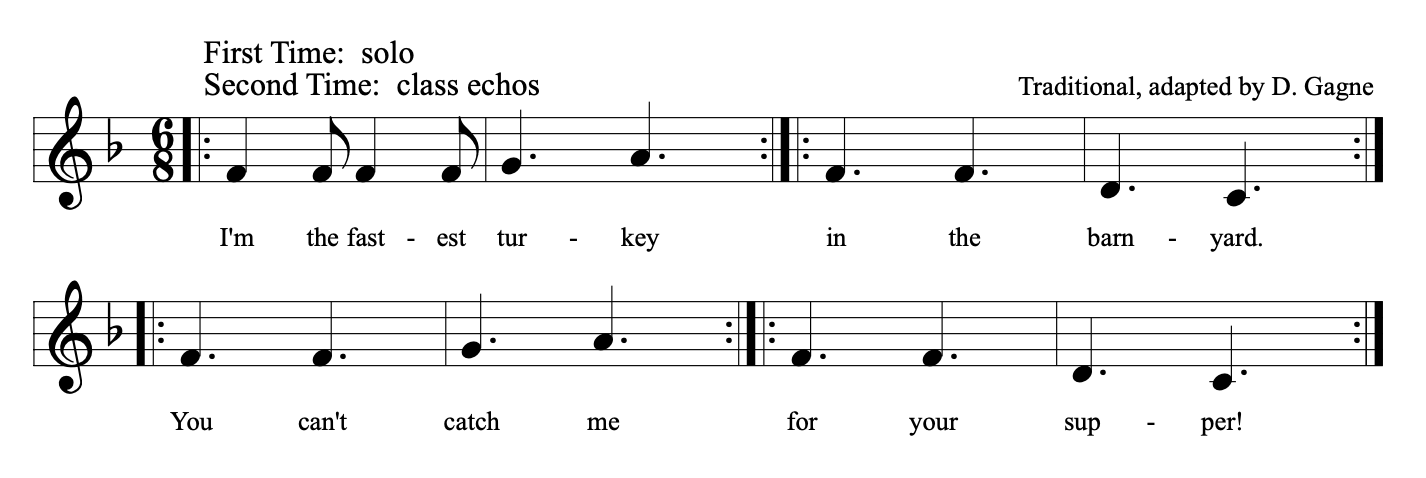
Musicplay Live
Registration for Musicplay Live in Washington, DC; Austin, TX; and Virtual is open!
Musicplay Workshops
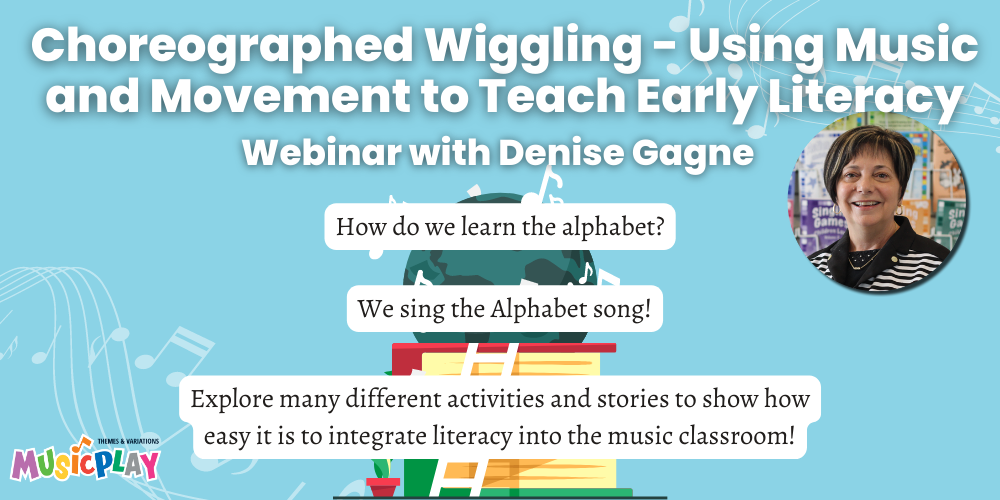
Check out our latest webinar on activities for using music and movement to teach early literacy!
Musicplay Minutes Podcast
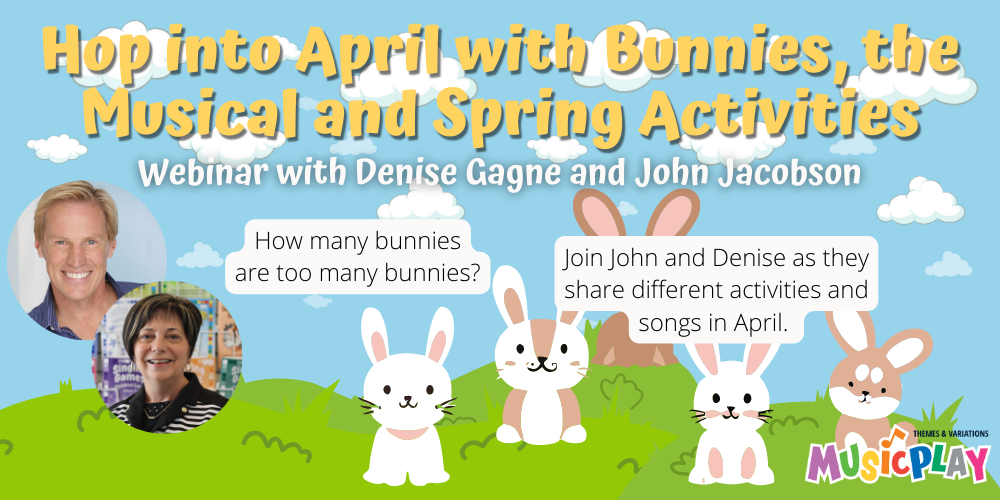
Listen to our newest podcast on ideas for Spring and Bunnies: The Musical!

.png?width=483&height=405&name=MusicplayLive%202023%20Sing!%20Say!%20Dance!%20Play!%20With%20Artie%2c%20Denise%2c%20and%20JJ%20Locations%20FB%20(2).png)
